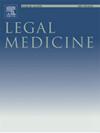采用hybridspe -沉淀法和LC-MS/MS快速测定中毒患者血浆样品中的丙戊酸
IF 1.3
4区 医学
Q3 MEDICINE, LEGAL
引用次数: 0
摘要
丙戊酸(VPA)是一种抗癫痫药物,用于癫痫,以及其他神经和精神疾病,如癫痫发作,双相情感障碍和偏头痛。它是一种中枢神经系统抑制剂,与过量服用有关,通常是出于自杀目的。毒性血浆VPA水平可导致各种临床表现,包括嗜睡、共济失调、昏迷和肝肾功能障碍。中毒病例的增加强调了识别有毒物质对有效患者管理和治疗的重要性,确保了积极的预后。本研究开发并验证了一种LC-MS/MS方法,用于分析紧急毒理学情景下血浆样品中的VPA。样品制备采用HybridSPE-PPT,血浆浓度为100 μL。总色谱运行时间为4分钟。该方法按照ANSI/ASB标准036指南的建议进行验证。定量下限为20 μg/mL,方法线性(r2 >;0.999),可达500 μg/mL。结果表明,该方法精密度高、准确度高,运行内、运行间精密度CV% < 9%,偏差在- 10.4%以内。基质效应范围为113.3% ~ 128.5%,HybridSPE-PPT回收率大于90%。为了证明该方法的适用性,对13例疑似中毒病例的血浆样本进行了分析。样品中发现的浓度范围为21.1 μg/mL至>;500μg / mL。采用HybridSPE-PPT技术建立了一种快速简便的LC-MS/MS定量血浆样品中VPA的方法,并进行了验证。本文章由计算机程序翻译,如有差异,请以英文原文为准。
Fast determination of valproic acid in plasma samples from poisoning cases using HybridSPE-precipitation and LC-MS/MS
Valproic acid (VPA) is an antiepileptic drug for epilepsy, as well as other neurological and psychiatric disorders, such as seizures, bipolar disorders, and migraines. It acts as a central nervous system depressant and is linked to overdose cases, often intentionally for suicidal purposes. Toxic plasmatic levels of VPA can result in various clinical manifestations, including drowsiness, ataxia, coma, and liver and kidney dysfunction. The rising cases of poisoning underscore the importance of identifying toxic agents for effective patient management and treatment, ensuring a positive prognosis. This study developed and validated an LC-MS/MS method to analyze VPA in plasma samples in emergency toxicology scenarios. Sample preparation was carried out using HybridSPE-PPT and used 100 μL of plasma. The total chromatographic run time was 4 min. The method was validated following the recommendations of the ANSI/ASB Standard 036 Guideline. The lower limit of quantification was 20 μg/mL and the method proved to be linear (r2 > 0.999) up to 500 μg/mL. The developed method proved to be precise and accurate, with within-run and between-run precision CV% lower than 9 % and bias within −10.4 %. The matrix effect ranged from 113.3 to 128.5 % and the HybridSPE-PPT recovery rate was greater than 90 %. As proof of applicability, thirteen plasma samples from suspected poisoning cases were analyzed. The concentration found in the samples ranged from 21.1 μg/mL to > 500 μg/mL. A fast and simple LC-MS/MS method using the HybridSPE-PPT technique for quantifying VPA in plasma samples was successfully developed and validated.
求助全文
通过发布文献求助,成功后即可免费获取论文全文。
去求助
来源期刊

Legal Medicine
Nursing-Issues, Ethics and Legal Aspects
CiteScore
2.80
自引率
6.70%
发文量
119
审稿时长
7.9 weeks
期刊介绍:
Legal Medicine provides an international forum for the publication of original articles, reviews and correspondence on subjects that cover practical and theoretical areas of interest relating to the wide range of legal medicine.
Subjects covered include forensic pathology, toxicology, odontology, anthropology, criminalistics, immunochemistry, hemogenetics and forensic aspects of biological science with emphasis on DNA analysis and molecular biology. Submissions dealing with medicolegal problems such as malpractice, insurance, child abuse or ethics in medical practice are also acceptable.
 求助内容:
求助内容: 应助结果提醒方式:
应助结果提醒方式:


